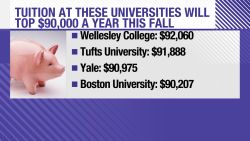Many of the world’s leading financial institutions have pledged in recent years to slash their support for the coal and oil industries. But a new report has found that hundreds of billions of dollars are still being channeled into fossil fuels, and Asia’s banks are doing much of that business.
Globally, 380 commercial banks lent the coal industry $315 billion over the past two years, according to the report, which was compiled by more than two dozen non-governmental organizations, including Urgewald, Reclaim Finance, Rainforest Action Network and 350.org Japan. The groups say their research is the first to analyze the financiers and investors supporting the entire coal industry.
The top three lenders to the coal industry were all Japanese: Mizuho (MFG), Sumitomo Mitsui Banking Corporation (SMFG), and Mitsubishi UFJ Financial Group (MBFJF). Collectively, Japanese banks provided $75 billion in loans between October 2018 and October 2020, according to the report.
Mitsubishi told CNN Business that as of May 2019, it said it would no longer provide financing for new coal-fired power generation projects, with some exceptions. It also said it would not consider financing for new coal projects going forward “unless it is confirmed that the project will contribute to innovative technologies or transitions towards achieving the Paris Agreement goals.”
Mizuho said that the NGO report “does not reflect the reality,” adding that the report uses only publicly available data. The bank said it takes issue with the way the report has counted the loans and how it selects “objective companies.”
“Mizuho sees sustainability as an integral part of our corporate strategy,” the company said. It added that it is working to “proactively support initiative for transitioning to a low-carbon society,” and has set financing goals to address climate change.
Sumitomo Mitsui said Friday that as of last year, it pledged to no longer offer services supporting “newly planned coal-fired power plants.” It added that it intends to reduce the balance of coal plant-related loans to zero by 2040.
While Japan leads the way in lending, the United States ranks second, providing loans worth $67.7 billion, or 21.5% of the total.
American firms are also more heavily invested in coal than others, according to the report. Of the more than $1 trillion that the report found has been invested in companies working in the industry worldwide as of January, more than $600 billion of that comes from US investors.
Meanwhile, the world’s top 10 underwriters — banks that raise investment capital for companies by issuing bonds or shares on their behalf and selling them to investors — are all Chinese financial institutions, the report found. Chinese banks channeled $467 billion to the coal industry over the past two years, more than half of the total examined by the report.
The report analyzed 934 companies on the Global Coal Exit List (GCEL), a database of companies operating along the thermal coal value chain compiled by Urgewald. It also found that financing for coal has actually increased in the years since the Paris Agreement, the landmark climate accord, went into effect. The total ticked up 11% between 2016 and 2019.
Since the Paris Agreement was signed, the world’s installed coal-fired power generation capacity has increased by 137 GW, an amount equal to the operating coal plants of Germany, Russia and Japan combined, according to the Global Coal Exit List. And over 500 GW of new coal-fired capacity are in the pipeline.
One of the main reasons for the increased investment is that globally coal remains the main energy source for electricity generation.
“Until investments are made in renewable energy, the fact is that people still need electricity. This is especially true in Asia as compared to the US or Europe where coal use is decreasing,” said Eri Watanabe, 350 Japan Finance Campaigner. “This is the main reason banks continue to invest, despite the fact that returns on investment are dipping.”
The United Nations says it is necessary to phase out fossil fuels — like coal — to stop the very worst impacts of man-made climate change. The Paris Agreement is a pact signed by almost all the world’s countries that seeks to limit global warming to well below 2°C and pursue efforts to limit it to 1.5°C. A recent report found that from now until 2030, the global production of coal would have to decline annually by 11% to reach this target.
In recent years, there has been some momentum among big banks to distance themselves from coal and oil companies whose long-term fortunes are threatened by the climate crisis. In 2019, Goldman Sachs (GS) became the first big US bank to pledge not to write loans for Arctic drilling. Last fall, JPMorgan Chase (JPM) said it would refuse lending, capital market and other services to companies that make most of their revenue from coal extraction.
But environmental groups say fossil fuel policies adopted by banks don’t go far enough and financial institutions should support their countries’ climate goals by divesting of coal investments at home and abroad.
“These numbers provide a sobering reality check on bank’s climate commitments,” said Yann Louvel, policy analyst for Reclaim Finance.
The NGO, which operates an online “Coal Policy Tool” that tracks and ranks financial institutions’ coal policies, said that 88 commercial banks have adopted a coal policy, but only four have “robust” coal exclusion policies.
“The new financial data confirms the findings of our Coal Policy Tool: The vast majority of banks’ coal policies have so many loopholes that their impact is almost meaningless,” said Louvel.
China the biggest coal underwriter, US the biggest investor
The world’s leading underwriters for coal are all Chinese, according to the report, which singled out the Industrial and Commercial Bank of China (ICBC), the China International Trust and Investment Corporation, and the Shanghai Pudong Development Bank as the top banks raising money for the industry.
ICBC and CITIC did not respond to requests for comment from CNN Business, while the Shanghai Pudong Development Bank could not be reached.
Chinese banks channeled $467 billion to the coal industry over the past two years through underwriting, followed by banks in the United States with $104 billion, then Japan, India and the United Kingdom.
In total, 427 commercial banks underwrote $808 billion to companies on the GCEL over the past two years.
350 Asia Finance Campaigner Chuck Baclagon said continued investments in coal projects from the world’s biggest banks will become even riskier as the world recovers from Covid-19.
“ICBC can become leaders by spearheading the transition to a clean, safe and just recovery as renewable energy investments generate returns while boosting employment opportunities. By doing so they can also contribute to China’s climate goals,” Baclagon said.
Meanwhile, US investors are making by far the biggest institutional investments in the global coal industry, with shares and bonds worth $602 billion — 52% of the market share.
Vanguard and BlackRock were the two largest institutional investors, holding more than $80 billion each, according to the report. They did not immediately respond to a request for comment from CNN Business.
Japanese investors come next, with holdings in the coal industry of $81 billion. The report found that Japan’s Government Pension Investment Fund alone holds bonds and shares in value of $29 billion in companies listed on the GCEL. The third largest group of investors are from the United Kingdom.
The United States, United Kingdom and Japan have all committed to achieve net zero carbon emissions by 2050, and China by 2060, but environmental groups say continued financing of fossil fuels will put those goals out of reach.
For example, Japan’s carbon neutral goals don’t highlight any concrete policy shifts for fossil fuel investment, according to 350.org.
“If these gaps are not addressed, what would happen is that nearer to 2050 they are going to realize that they can’t meet those goals, and by that time we might have missed our chance to limit warming,” said Watanabe.
What is needed from the banking industry is a “speedy exit from coal finance” as a “question of survival,” she added.
“What we need are comprehensive, immediate coal exit policies,” said Louvel. “Insurers such as AXA (AXAHF), banks like Crédit Mutuel, UniCredit (UNCFF) and Desjardins or asset managers like Ostrum have already shown what must be done by excluding most of the companies on the Global Coal Exit List from their portfolios. Now is the time for the finance industry to act.”
– Chie Kobayashi contributed to this report.
CORRECTION: An earlier version of this article misstated the percentage of market share that US investors account for in the global coal industry. The figure is 58%.


























